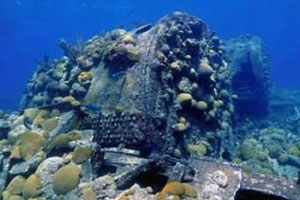Besides its pink-sand beaches and lavish landscape, Bermuda has more than enough to offer in its aquamarine waters—the Bermuda shipwrecks. These shipwrecks in Bermuda provide divers with pristine opportunities to journey through centuries of history. Therefore, don’t hesitate to book a Bermuda shipwreck dive whenever you visit this fantastic island in the North Atlantic Ocean.
Dive Into the Shipwreck Capital of the World
With more than 300 shipwrecks surrounding its waters, it’s not a surprise that Bermuda is considered the shipwreck capital of the world. Bermuda is also ranked at the top spot for shipwrecks per square mile.
However, how most are found in the shallow waters surrounding the island sets shipwrecks in Bermuda apart from any other place in the world. Coupled with how clear the waters in Bermuda are throughout the year, every dive into the shipwrecks is a dive into rare sightings. Therefore, you can be sure of a scenic, photogenic, and unforgettable snorkeling adventure in Bermuda.
Explore Wrecks From Every Era
You can travel through history by exploring the shipwrecks in the Bermuda Triangle. The wrecks span from as early as the 15th century through to the late 20th century, offering more than five centuries’ worth of maritime history to explore and appreciate. With each sunken vessel, you have a rare occasion to immerse yourself in the unique attributes, technology, and ideologies that characterized that age. From the American Civil War sunken ships to the wrecks of the Second World War, every ship wreckage in Bermuda has something peculiar to offer from every era.
Some of the favorite, must-see wreck sites in Bermuda include:
Mary Celestia
It’s one of the oldest wrecks still with most of its parts intact and visible. This Civil War-era, 100-foot paddle steamer sunk in 1884 when it hit one of the coral reefs in the Bermuda Triangle. Today, divers are greeted with a picturesque view of the intact engine and paddlewheel, as well as the stern, bow, boilers, and anchor. It also made headlines in 2015 when a few 150-year-old unopened wine bottles were discovered after Mary Celestia’s wreckage was exposed above the water.
Cristóbal Colón
Scattered over an area of approximately 100,000 square feet, at a depth of up to 60ft, this is undoubtedly the largest shipwreck site in Bermuda waters. The 499ft/152m long sunken vessel was a Spanish luxury liner that crashed when it hit a coral reef in November 1936, after just over a decade of colonizing the seas. While she was mostly stripped and salvaged over the years and used as the bombing practice target by the British Royal Airforce during World War II, the expansive Cristóbal Colón wreckage is breathtaking and photogenic to explore thanks to its abundance of marine life.
King
For a more modern exploration, dive into the wreckage of the King, which was intentionally sunk in 1984 after her owner gifted her to the Bermuda Dive Association. Nowadays, the site has become popular for divers to spot shells and tropical fish like trumpetfish and blue angels.
Book a Shipwreck Tour to Explore the Sites Listed Below
Today, the underwater heroes of their time in Bermuda give scuba divers, snorkelers, and other sea lovers among the best wreck diving sites in the world. These Bermuda shipwrecks open a rare window into the past maritime history and exploration of the most famous North Atlantic Island.
Besides the one already covered, other shipwrecks in Bermuda that amaze both locals and visitors include:
Ready to explore these exceptional and rare shipwrecks in Bermuda? Book a shipwreck tour now at bermuda.com to get started or to read more regarding diving and snorkeling in Bermuda.















